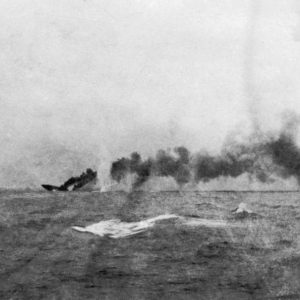Jutland, the one great naval battle of World War I, was fought a hundred years ago this week. On May 31, 1916, the German High Seas Fleet and the British Grand Fleet met in the North Sea, just west of Denmark, and bombarded each other with immense guns that could fire armor-piercing shells more than 10 miles. The battle ended that night, as Britain’s Adm. John Jellicoe was unable to close on his foe in the dark. Each side claimed victory, but each feared that it had actually lost.
The long buildup to the battle had begun in 1890, when Alfred Thayer Mahan, an instructor at the U.S. Naval Academy published “The Influence of Sea Power Upon History.” The reason for Britain’s imperial and commercial power, he wrote, was its naval dominance. Sea power equals world power. Aspiring imperial nations took his message to heart, especially Germany and Japan. Japan’s crash-course in industrialization and navy building, using Britain as its model, culminated in an astounding victory for Japan’s fleet over Russia’s at the Battle of Tsushima in 1905.
Britain, aware that Germany was now also building warships, resolved to keep its lead, partly by outbuilding all rivals and partly with innovative designs. Its Dreadnought, launched in 1906, was so fast and powerful that it rendered every other fighting ship in the world obsolete. For the next 10 years Britain and Germany alike built Dreadnought-style steam-turbine ships, improving their speed and firepower so rapidly that each new variant on the basic design outdid its immediate predecessors.
The last time Britain had fought a major fleet action was Trafalgar in 1805, under its greatest seafaring hero, Horatio Nelson. In those days wooden sailing ships, huge floating gun platforms, closed to short range and fired broadsides into each other. By 1914, when World War I began, no one in the Royal Navy had battle experience, and no one quite knew how the technological revolutions of the last century would play out in a big-ship encounter. Germany, meanwhile, had never fought a major fleet action. Its sailors were eager to make a name for themselves as deep-water mariners.
At Jutland, the Royal Navy had an advantage in numbers (155 ships to 99), in speed and in gunnery range. The German ships were more heavily protected with steel armor, were better prepared for night fighting, and had better ship-to-ship communications.
In the first encounter, on the afternoon of May 31, the British battle-cruiser commander, Adm. David Beattie, failed to attack the German ships when his guns could reach them but theirs were still out of range. By the time he did open fire he had lost his advantage. Two of his principal ships suffered direct hits, exploded, and sank with all hands.
When the entire fleets engaged, however, the German commander, Adm. Reinhard Scheer, quickly realized that his force would be shattered if he took on the full weight of the British battleships. By a succession of daring maneuvers he broke off contact in the murky late afternoon light and zigzagged for home under cover of darkness. Germany had lost 11 ships, Britain 14. Of the 8,500 men killed that day, nearly two thirds were British. Jellicoe had not scored a Nelson-style knockout victory.
At once the analysis and the recriminations began. They have continued for a hundred years, with different authors coming to different conclusions, often contradictory but equally persuasive. Was Jellicoe too cautious? Should he have prepared better for night action? Was British signaling deficient? Did the Royal Navy’s captains lack initiative? Why had British naval intelligence failed to forward decrypted German messages to the admirals in action?
Winston Churchill once commented that Jellicoe was “the only man on either side who could lose the war in an afternoon.” No wonder he was cautious!
Despite these issues one thing remains clear. After Jutland, Germany’s High Seas Fleet never again challenged the Royal Navy. Instead it lay rusting in port. Germany switched its naval efforts to unrestricted submarine warfare in the North Atlantic. Britain depended for food on the United States and Canada. German leaders hoped that their U-boats, by sinking freighters, could starve Britain into submission. But that decision brought the United States into the war early in 1917, which in turn made it far more likely that the Allies would win. They did.
By the time great fleets again came to blows, in World War II, the crucial weapon was no longer the battleship but the aircraft carrier. The battles of Coral Sea and Midway, in 1942, showed that naval guns firing 10 miles had been eclipsed by ship-borne aircraft that could project the ship’s power 200 miles in any direction.
It was a sign of things to come that, at the end of World War I the German captains, ordered to hand over their vessels to the British admiralty, scuttled them instead. Dreadnought battleships, literally and figuratively, sank beneath the waves.

